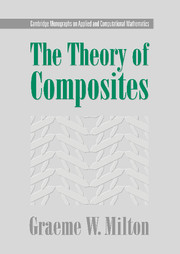Book contents
- Frontmatter
- Contents
- List of figures
- Preface
- 1 Introduction
- 2 Some equations of interest and numerical approaches to solving them
- 3 Duality transformations in two-dimensional media
- 4 Translations and equivalent media
- 5 Some microstructure-independent exact relations
- 6 Exact relations for coupled equations
- 7 Assemblages of spheres, ellipsoids, and other neutral inclusions
- 8 Tricks for generating other exactly solvable microgeometries
- 9 Laminate materials
- 10 Approximations and asymptotic formulas
- 11 Wave propagation in the quasistatic limit
- 12 Reformulating the problem of finding effective tensors
- 13 Variational principles and inequalities
- 14 Series expansions for the fields and effective tensors
- 15 Correlation functions and how they enter series expansions†
- 16 Other perturbation solutions
- 17 The general theory of exact relations and links between effective tensors
- 18 Analytic properties
- 19 Y-tensors
- 20 Y-tensors and effective tensors in electrical circuits†
- 21 Bounds on the properties of composites
- 22 Classical variational principle bounds
- 23 Bounds from the Hashin-Shtrikman variational inequalities
- 24 Bounds using the compensated compactness or translation method
- 25 Choosing the translations and finding microgeometries that attain the bounds†
- 26 Bounds incorporating three-point correlation functions†
- 27 Bounds using the analytic method
- 28 Fractional linear transformations as a tool for generating bounds†
- 29 The field equation recursion method†
- 30 Properties of the G-closure and extremal families of composites
- 31 The bounding of effective moduli as a quasiconvexification problem
- Author index
- Subject index
7 - Assemblages of spheres, ellipsoids, and other neutral inclusions
- Frontmatter
- Contents
- List of figures
- Preface
- 1 Introduction
- 2 Some equations of interest and numerical approaches to solving them
- 3 Duality transformations in two-dimensional media
- 4 Translations and equivalent media
- 5 Some microstructure-independent exact relations
- 6 Exact relations for coupled equations
- 7 Assemblages of spheres, ellipsoids, and other neutral inclusions
- 8 Tricks for generating other exactly solvable microgeometries
- 9 Laminate materials
- 10 Approximations and asymptotic formulas
- 11 Wave propagation in the quasistatic limit
- 12 Reformulating the problem of finding effective tensors
- 13 Variational principles and inequalities
- 14 Series expansions for the fields and effective tensors
- 15 Correlation functions and how they enter series expansions†
- 16 Other perturbation solutions
- 17 The general theory of exact relations and links between effective tensors
- 18 Analytic properties
- 19 Y-tensors
- 20 Y-tensors and effective tensors in electrical circuits†
- 21 Bounds on the properties of composites
- 22 Classical variational principle bounds
- 23 Bounds from the Hashin-Shtrikman variational inequalities
- 24 Bounds using the compensated compactness or translation method
- 25 Choosing the translations and finding microgeometries that attain the bounds†
- 26 Bounds incorporating three-point correlation functions†
- 27 Bounds using the analytic method
- 28 Fractional linear transformations as a tool for generating bounds†
- 29 The field equation recursion method†
- 30 Properties of the G-closure and extremal families of composites
- 31 The bounding of effective moduli as a quasiconvexification problem
- Author index
- Subject index
Summary
Since the effective properties of a composite depend in a complicated way on the microstructure, it is useful to have realistic model composites for which the effective properties can be computed exactly. One such model, called the coated sphere assemblage, was introduced by Hashin (1962) as a model of a composite comprised of spherical grains of one phase embedded in a matrix of a second phase. This model and its generalizations are the subject of this chapter.
The coated sphere assemblage
Hashin (1962) found that the effective bulk modulus of the assemblage could be computed exactly for all volume fractions of the phases. Using a similar analysis, Hashin and Shtrikman (1962) found an exact expression for the effective conductivity of the assemblage. To see how their argument works, consider a coated sphere consisting of a spherical core of phase 1 of isotropic conductivity σ1I fitting snugly inside a concentric spherical shell of phase 2 of isotropic conductivity σ2I, with a core radius c and exterior radius e. This coated sphere is inserted as an inclusion in an infinite matrix of conductivity σ0I within which a uniform current field flows from infinity. Suppose for the moment that σ1 > σ2. From a physical standpoint it is clear that when σ0 = σ1 the inclusion has lower conductivity than its surroundings and current will tend to flow around this obstacle.
- Type
- Chapter
- Information
- The Theory of Composites , pp. 113 - 142Publisher: Cambridge University PressPrint publication year: 2002
- 2
- Cited by



